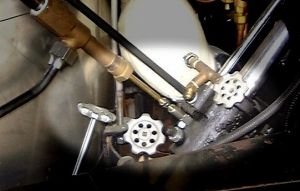|
The process of boiling water into steam causes only
the water to turn into steam. All the impurities and such remain
behind. As you drive a steam car you're constantly converting water
into steam and that steam eventually leaves the car (all the packings are
not perfectly tight; condensing cars don't condense all the steam used, etc)
so that you have to refill the water supply tank that replenishes the boiler
as you drive. This means that you are constantly putting "dirty water"
into the boiler while only pure water leaves the car in the form of escaped
and exhausted steam.
This process of "blowing down the boiler" allows the
water in the boiler that has become contaminated with impurities to be
expelled so that fresh, less contaminated water can take its place. If
a driver fails to perform this task the boiler eventually develops a thin
layer of these deposits on the bottom surface of the boiler. This
material acts as in insulator and doesn't allow good heat transfer from the
bottom metal plate of the boiler into the water contained in the boiler.
The result is the boiler doesn't "steam" as well ~ it doesn't produce steam
as efficiently for a gallon of fuel burned as it did when the boiler is new.
The process of blowing down the boiler helps to wash this material out of
the boiler so that it continues to heat and operate at peak efficiency.
If this material build-up gets too thick on the bottom
of the boiler then most of the heat transmission through the steel and into
the water will cease and the steel plate bottom of the boiler actually
starts to overheat because there is no water (just the insulating effect of
the deposits) in contact with the steel keeping the steel cool. This
can create serious damage to the boiler and generally results in the flue
tubes starting to leak where they are fitted to the steel plate bottom (flue
sheet) of the boiler.
Another
serious effect of not regularly blowing down a boiler is the phenomenon of
"foaming". Impurities and chemicals can build up in the boiler water
to the point that the bubbles of steam start forming on the impurities
suspended in the water. Instead of a normal rate of steam being
generated all of a sudden there's a rapid increase in the generation of
steam. This rapid steam generation makes the water take on a
consistency not unlike the white foamy head on a freshly drawn beer or what
results if you take a warm, well shaken can of soda and open it. Now,
instead of pure steam going to the engine you have foam going to the engine.
As the foam is a high percentage of water and there are very close
tolerances within the engine cylinders, if too much foam gets into the
cylinders the water in the foam won't compress like steam and blowing the
cylinders apart becomes a real possibility along with other significant
engine damage. In a like manner the foam with all it's impurities
going through the superheater will cause the water to flash into steam while
the impurities are left behind on the walls of the superheater causing it to
become less efficient. An experienced steam car owner will hopefully
recognize the decreased performance of the boiler, the erratic operation of
the car's gauges, and the way the engine is running as attributed to boiler
foaming and shut the car down before any serious damage can occur.
Depending on the
model Stanley in question, one or more blow off valves could be located
around the perimeter of the boiler. On restored Stanley cars it is not
uncommon to see three, four, or five valves around the lower perimeter of
the boiler for blow off purposes. In addition to the blow off valves around the lower
perimeter of the boiler there are also additional ones serving specific
purposes. One device not shown on the diagram is the boiler water
level indicator. There were several forms of devices used to indicate
the water level in a boiler. Most notably was the three-tube indicator
on earlier cars. Later models used what was called a kidney indicator
which was a float-based system. Both of these indicator system
included blow off valves to clear their lines to insure accurate readings.
When opening a blow off valve it is
good practice not to close the valve tight initially. Sometimes small
bits of grit and rust can get lodged on the valve seat during the blowing
down operation. These debris will not allow the valve stem to seat
properly and if the handle is closed tightly the debris may be ground into
the soft brass valve seat. The rotation of the valve stem on the valve
seat will also cause the debris to cut grooves in the seat which become the
pathways for the valve to leak.
A recommended practice is to close
the valve just to the valve stem reaches the valve seat. At that point
it is good practice to open the valve a quarter turn and reseat the valve
stem on the seat. If with a little bit of pressure the valve closes
then that is how it should be left. If the valve does not close off
then repeat the opening and reseating a couple more times. Observe the
end of the blown down line connected to the valve for leaking but remember
that it may appear to be leaking when it is really the remaining steam and
water in the line draining. If the valve continues to leak then it
will be necessary to dress the valve seat and the end of the valve stem to
make a better seal. |
